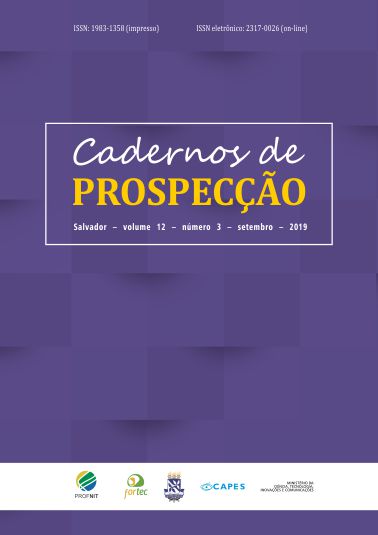Technological Convergence Applied to Patent Documents on Sugarcane Seedlings’s Production Techniques through Co-classiication Analysis
DOI:
https://doi.org/10.9771/cp.v12i3.27820Keywords:
Technological convergence, Patents, Co-classification, Seedlings of sugarcane.Abstract
Technological convergence studies generally use complex analyzes, such as co-citations , co-words, co-authorship, involving papers and patent. This paper describes a simple methodology to be applied to studies of technological convergence by the co-classification analysis of patent documents. A technological mapping was carried out through an advanced search in the Derwent Innovation Index base about the production of sugarcane seedlings between 2000 and 2016. The technological convergence rates between technological fields of the same section (intra-section) and between different sections (inter-section) of the Derwent classifications were calculated. The results point to relatively low convergence rates, reaching 8.36% for intra-section convergences in 2014 and 5.81% for inter-section convergences in 2012. The predominant Derwent classifications were the fermentation, biotechnology and plant crop industry, associated to the techniques of production of seedlings by genetic engineering / plant breeding and control of diseases and pests. Converging technologies are in cutting-edge areas such as biotechnology, which need disciplinary complementarity in the innovation process to achieve agricultural productivity gains, cost savings, and innovations in plant breeding. The contribution of this work is in the description of a methodology that can be applied to other types of patent classification in different technological areas.
Downloads
References
BORGES, I. D. C.; POZ, D. Impactos da Biotecnologia Moderna no Agronegócio Brasileiro. p. 1–20, 2001.
CHOI, J. Y.; JEONG, S.; KIM, K. A study on diffusion pattern of technology convergence: Patent analysis for Korea. Sustainability (Switzerland), v. 7, n. 9, p. 11.546–11.569, 2015.
CURRAN, C.; BRÖRING, S.; LEKER, J. Technological Forecasting & Social Change Anticipating converging industries using publicly available data. Technological Forecasting & Social Change, v. 77, n. 3, p. 385–395, 2010. Disponível em: <http://dx.doi.org/10.1016/j.techfore.2009.10.002>. Acesso
em:
JANNUZZI, A. H. L.; AMORIM, R. D. C. R.; SOUZA, C. G. DE. Implicações da categorização e indexação na recuperação da informação tecnológica contida em documentos de patentes. Ciência da Informação, v. 36, n. 2, p. 27–34, 2007.
JEONG, S.; KIM, J. C.; CHOI, J. Y. Technology convergence: What developmental stage are we in? Scientometrics, v. 104, n. 3, p. 841–871, 2015.
RUAS, T. L.; PEREIRA, L. Como construir indicadores de Ciência , Tecnologia e Inovação usando Web of Science , Derwent World Patent Index , Bibexcel e Pajek ? Perspectivas em Ciência da Informação, p. 52–81, 2014.
SMITH, M. et al. NodeXL:L: a free and open network overview, discovery and exploration add-in for Excel 2007/2010/2013/2016. [S.l.]: Social Media Research Foundation, http://www.smrfoundation.org. Disponível em: <http://nodexl.codeplex.com/>. , 2010
SNYMAN, S. J. et al. Applications of in vitro culture systems for commercial sugarcane production and improvement. In Vitro Cellular and Developmental Biology - Plant, v. 47, n. 2, p. 234–249, 2011.
SONG, C. H.; ELVERS, D.; LEKER, J. Anticipation of converging technology areas ??? A refined approach for the identification of attractive fields of innovation. Technological Forecasting and Social Change, v. 116, p. 98–115, 2017.
VAN ECK, N. J.; WALTMAN, L. VOSviewer - Visualizing scientific landscapes . [S.l: s.n.]. Disponível em: <http://www.vosviewer.com/>. Acesso em: 12 abr. 2017.
Downloads
Published
How to Cite
Issue
Section
License
Copyright (c) 2019 Cadernos de Prospecção

This work is licensed under a Creative Commons Attribution-NonCommercial 4.0 International License.
O autor declara que: - Todos os autores foram nomeados. - Está submetendo o manuscrito com o consentimento dos outros autores. - Caso o trabalho submetido tiver sido contratado por algum empregador, tem o consentimento do referido empregador. - Os autores estão cientes de que é condição de publicação que os manuscritos submetidos a esta revista não tenham sido publicados anteriormente e não sejam submetidos ou publicados simultaneamente em outro periódico sem prévia autorização do Conselho Editorial. - Os autores concordam que o seu artigo ou parte dele possa ser distribuído e/ou reproduzido por qualquer forma, incluindo traduções, desde que sejam citados de modo completo esta revista e os autores do manuscrito. - Revista Cadernos de Prospecção está licenciado com uma Licença Creative Commons Attribution 4.0. Esta licença permite que outros remixem, adaptem e criem a partir do seu trabalho para fins não comerciais, e embora os novos trabalhos tenham de lhe atribuir o devido crédito e não possam ser usados para fins comerciais, os usuários não têm de licenciar esses trabalhos derivados sob os mesmos termos.
Este obra está licenciado com uma Licença Creative Commons Atribuição 4.0 Internacional.








